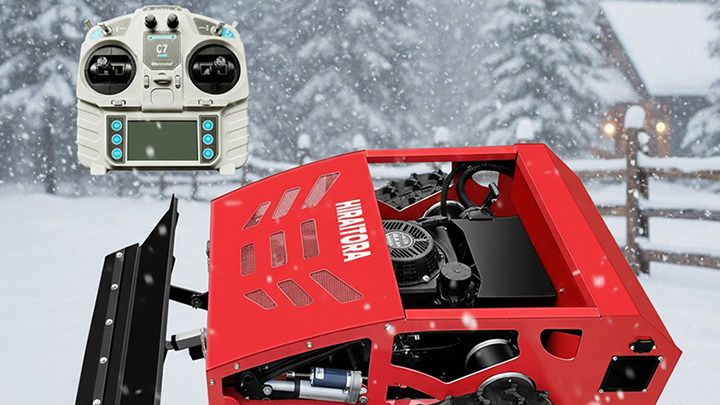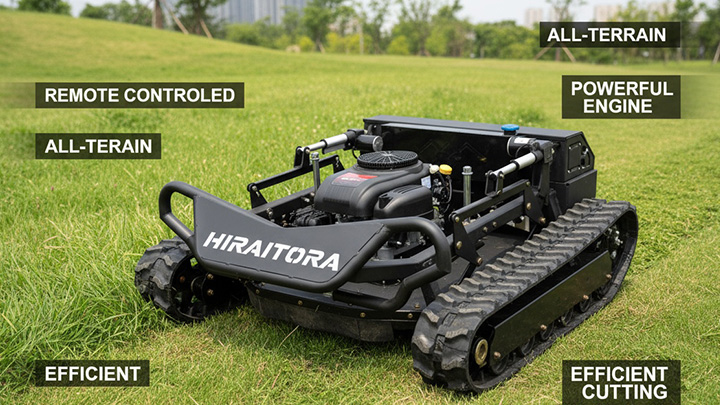Remote Control vs. Walk-Behind Mower: Which is the Better Choice for Your Lawn?
Mowing the lawn is a classic chore, but the tools for the job have evolved significantly. For many homeowners, the choice is no longer just about engine size, but about how you interact with the machine. The traditional walk-behind mower now faces a modern challenger: the remote-controlled mower.
So, which one is better? The answer, as with most tools, depends entirely on your specific lawn and your personal preferences. Let's break down the strengths and weaknesses of each.
The Modern Marvel: Remote-Controlled Mowers
These mowers allow you to steer and control the machine from a distance using a handheld transmitter, much like a large radio-controlled car.
Key Advantages:
- Effortless Operation on Slopes: This is their single greatest advantage. If you have a steep, uneven, or difficult-to-walk-on yard, a remote-controlled mower is a game-changer. You can mow from a stable, safe spot on flat ground, eliminating the physical strain and danger of slipping while pushing a heavy mower uphill.
- Superior Maneuverability: With precise joystick or button control, you can easily navigate around tight corners, garden beds, and obstacles with a level of precision that is difficult to achieve with a self-propelled walk-behind mower.
- Reduced Physical Fatigue: There is no pushing, pulling, or turning a heavy machine. Your role shifts from operator to pilot, which is a significant benefit for those with mobility issues, joint pain, or who simply want to minimize physical exertion.
- Fun Factor: Let's be honest, driving a mower with a remote control is simply more engaging and fun for many people.
Key Disadvantages:
- High Cost: Remote-controlled mowers are a premium product. They are significantly more expensive than most walk-behind mowers, often costing two to three times as much.
- Increased Complexity: More technology means more potential points of failure. The electronic control systems, servos, and transmitters can be costly to repair if they break down, compared to the purely mechanical systems of a basic walk-behind mower.
- Battery Dependency: Most remote-controlled mowers are battery-powered. While this is quiet and emission-free, you are limited by battery life. For very large lawns, you may need to invest in extra batteries or risk not finishing the job in one charge.
- Less Exercise: While a pro for some, this is a con for others. Mowing the lawn with a walk-behind mower can be a form of moderate cardio exercise that you lose with a remote control.
The Tried-and-True: Walk-Behind Mowers
The standard by which all other mowers are measured. This category includes both simple push mowers and self-propelled models that drive themselves, requiring you only to guide them.
Key Advantages:
- Proven Reliability and Simplicity: The technology is mature and widely understood. They are generally simpler machines, which often translates to greater long-term reliability and easier, less expensive repairs. Any small-engine mechanic can service one.
- Lower Cost: Walk-behind mowers offer the best value. You can get a highly capable gas or battery-powered model for a fraction of the cost of a remote-controlled unit.
- Power and Runtime Options: You can choose between gas models (unlimited runtime, high power) and battery models (quiet, low maintenance). Gas models are ideal for very large lawns where battery life might be a concern.
- Provides Exercise: Using a push or even a self-propelled mower is a legitimate form of physical activity, which can be a positive for your health.
Key Disadvantages:
- Physical Effort Required: Even self-propelled models require you to walk the entire lawn, turn the machine, and keep up with its pace. On hills and in hot weather, this can be strenuous and unpleasant.
- Challenging on Slopes: Mowing across or up a steep slope with a walk-behind mower is tiring and can be hazardous due to the risk of slipping or the mower rolling.
- Less Precise Control: While you develop skill over time, guiding a self-propelled mower around intricate flower beds is generally less precise than piloting a remote-controlled model.
The Verdict: Making the Right Choice
Your decision should be guided by your terrain, your budget, and your physical needs.
Choose a Remote-Controlled Mower IF:
- Your yard has significant slopes, hills, or uneven terrain.
- You have physical limitations, mobility issues, or simply want to minimize exertion.
- You value precise, easy maneuvering around many obstacles.
- Your budget is flexible, and you are willing to pay a premium for convenience.
Choose a Walk-Behind Mower IF:
- Your lawn is mostly flat or has gentle slopes.
- Budget is a primary concern, and you are looking for the best value.
- You prefer a simpler, more repairable machine or want the unlimited runtime of a gas engine.
- You view mowing as a form of exercise and don't mind the physical activity.
Conclusion:
There is no single "better" option—only the right tool for the person and the property. For the average flat suburban lawn, a self-propelled walk-behind mower remains the most cost-effective and efficient choice. However, if your landscape is challenging, the innovative convenience of a remote-controlled mower isn't just a luxury; it's a logical and back-saving solution that can transform a difficult chore into a simple task. Assess your yard, be honest about your needs, and invest accordingly.




